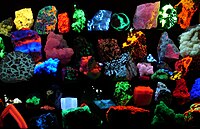
Photo from wikipedia
ABSTRACT Nowadays, the abuse of illegal drugs has been an increasingly grim problem in the world. Excitation–emission matrix fluorescence combined with parallel factor analysis was used to make a quantitative… Click to show full abstract
ABSTRACT Nowadays, the abuse of illegal drugs has been an increasingly grim problem in the world. Excitation–emission matrix fluorescence combined with parallel factor analysis was used to make a quantitative analysis of the simulated amphetamine-type illegal drugs. Satisfactory results were achieved for simultaneous determination of methamphetamine (MAM) and 3, 4-methylenedioxymethamphetamine (MDMA) in the presence of adulterants. The average recoveries were (99.8 ± 0.6)% and (101.6 ± 5.7)% for MAM and MDMA, respectively. Figures of merit including root-mean-square error of calibration and prediction, sensitivity and selectivity were investigated to evaluate the performance of the proposed method. The limits of detection were 0.054 and 0.002 1 μg/mL for MAM and MDMA, respectively.
Journal Title: Forensic Sciences Research
Year Published: 2019
Link to full text (if available)
Share on Social Media: Sign Up to like & get
recommendations!